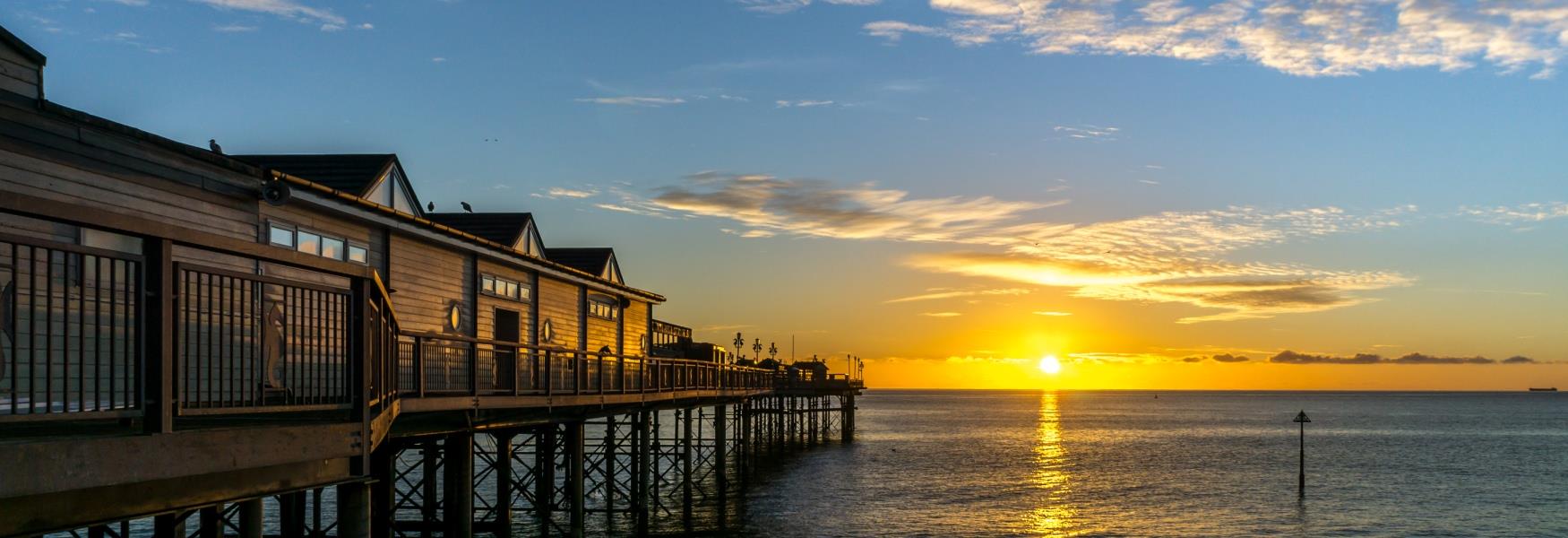
For centuries Devon has been the setting for many a devilish tale of pixies, ghosts and other supernatural creatures, passed down from generations via fireside stories and books. Whilst in these fables some of the mythological entities mean no harm, there’s still plenty who terrorised the ancient settlers in Devon, causing death and violence to whoever encountered them. Stories of the Devil, haunted animals and evil spirits have been concocted around various locations in the region, in particular Dartmoor – with its imposing tors, eerie woodlands and bouts of thick, heinous fog, it’s clear to see why. With the spooky season is upon us, what better time to round up some of the best South Devon folklore.
The Pixies of Devon
If you’re clued-up on mythological creatures, you may already be aware that the idea of pixies originated in Devon and Cornwall. In Devon these tiny beings are said to be almost invisibly small and harmless to mankind. The pixies associated with Dartmoor disguise themselves with rags and are usually timid, shy and of good nature, but can be particularly mischievous for anyone who offends them. They have been known to mislead unkind travellers, causing them to get lost, in which the remedy is to turn your coat inside out. In some of these stories the pixies have been depicted as near-human stature. One of these tales presents a member of the Elford family in Tavistock who hid from Cromwell's troops in a pixie house, which is now known as a cavern on Sheep Tor and can be visited via Yelverton.
The Hairy Hands of Dartmoor
This tale is perhaps one of the most iconic folklore stories in all of Devon. The legend is set in Postbridge on Dartmoor, specifically on the road known as the B3212 and involves a pair of disembodied hands that appear and suddenly grab the wheel of a moving vehicle, forcing the victim off the road. Sometimes these hands are depicted as gruesomely hairy and sometimes they’re invisible, but the sensation of the vehicle jolting and violently swerving off the road remains the same. Whilst this story is just that – a story, a widely disproportionate number of accidents have happened on this road. Almost all of the victims lived to tell the tale, but there was one incident of death. A doctor, by the name of E.H Helby was driving here when he lost control of his motorcycle, crashed and subsequently died. However, the two young girls, daughters of the Dartmoor Prison governor, who accompanied him on the side car, survived. Apparently it’s not just drivers who have experienced these hostile hands, in the 1920s a couple were camping in a caravan in the area when they were suddenly woken in the middle of the night by a heart-racing fear. The women witnessed a large, hairy hand crawling up the window. She instinctively made the sign of the cross and the hand scurried away. It’s suggested that the ghostly hands belong to an unnamed man who died in an accident on the road and has been haunting it ever since.
The Parson and the Clerk of Dawlish
The story of the Parson and the Clerk is set between Teignmouth and Dawlish. It starts with the Bishop of Exeter falling gravely ill and a local priest hoping to take on the role after his successors demise. This priest was accompanied by his clerk on the journey to visit the bishop when a terrible storm struck their path whilst crossing Haldon moor, causing them to trail off and become lost. In his frustration the priest shouted at the clerk ‘I’d rather have the Devil himself, than you, for a guide!” and suddenly a horseman rode by and volunteered to be their guide, an offer they happily accepted. They were taken to a beautiful mansion where they spent the night before finding out the bishop had passed away. The parson and clerk, alongside their horseman guide got ready to leave to take advantage of this newly vacant role, however the horses who drove their carriage refused to move. The parson wrestled with them, becoming angrier until he screamed ‘Devil! Take these bloody brutes!”. Suddenly the guide grabbed the reins and with lightning speed, drove them over the cliff. It’s said that this horseman was in fact the Devil himself and he turned the parson and the clerk into stone, where they face the sea for all of eternity. You can see these stacked stones, named the parson and the clerk, from the beach in Dawlish.
Devil’s Rock on Dartmoor
Overlooking the River Plym on the southwestern edge of Dartmoor is the Dewerstone, a site of an Iron Age Hill Fort. “Dewer” is an ancient Celtic word for the Devil and legend has it, this demonic hunter used to occupy the moors, riding a gigantic black horse, and leading a phantom pack of hounds. It’s been said that the Devil would chase weary travellers who had become lost on the moors at night over the Dewerstone to their deaths. Many legends have reported imprints of cloven hoofs being found near human footprints at the scene of tragedies. Of course, Dartmoor is known to be home to many sheep and cattle which roam and graze on the land, which would be the most logical explanation, but where’s the fun in that?!
Bowerman’s Nose, Dartmoor
There are many granite tors on Dartmoor that boast intriguing legends. Many years ago, lived a man known as Bowerman the Hunter. He owned a large pack of fierce hounds and spent his days hunting on the moors. One day he came across a group of witches holding a Sabbath whilst hunting hares. As well as crashing their rites, he was not frightened of the witches, and encouraged villagers not to be afraid, making them angry so they plotted their revenge. One of the witches, by the name Levera, turned herself into a hare, enticing Bowerman to chase her. She led him on a gruelling hunt over many hours across the moors and once he had exhausted himself, she led him to an area where the witches were hiding. With a powerful shriek, they turned Bowerman into stone. Bowerman’s Nose, which looks unusually human-like is said to be his remains and Hound Tor in present day is thought to be his pack of hounds.
Kitty Jay’s Grave, Dartmoor
The story of Kitty Jay is one of tragedy – a young woman who fell victim to suicide after falling pregnant and disowned by the father of her baby. She was denied a Christian burial and was instead buried at a crossroad, which was custom for those who died by their own hand in order to confuse their spirit, so it didn’t haunt the living. Fresh flowers, candles and crosses have been regularly placed on the grave site, but no one knows where they came from. It’s suggested that pixies are responsible for bestowing these gifts, but a few late-night drivers have said to have seen a ghostly figure of a robed man kneeling at the grave, only to turn around and face the driver in the rear-view mirror, eyes burning into them. The grave can be found on the western side of Dartmoor between Bowerman’s Nose and Hound Tor.
Cutty Dyre, Ashburton
The story of Cutty Dyre is not for the faint hearted. There’s been many depictions of this legend, but the heart of the story remains the same. According to some, he’s an evil water sprite, or an ogre who has a penchant for luring troublesome children. He’d entice them into the banks of the River Yeo (now the Ashburn River) before dragging them into the icy waters where he’d slit their throats and feast on their warm blood. Whilst young boys were his usual victims, foolish drunken adults who crossed paths with him were not spared. In the stories of Cutty Dyer, he was particularly fond of terrorising those who travelled across King’s Bridge in the centre of Ashburton. It’s thought that this story was an old wives’ tale told to naughty children to ensure they remained well-behaved and stayed away from this area, but to this day many locals say they have a childish but innately strange feeling when walking this path.
The Ghost of Okehampton Castle
According to local legend, the ghost of Lady Howard haunts what remains of Okehampton Castle. Every night at midnight she travels to Okehampton accompanied by a huge black dog with red eyes, followed by a large horse drawn carriage made of her previous husband’s bones, driven by a headless coachman. When they reach the castle they pluck a single blade of grass on the mound before returning to her previous residence, Fitzford House where the piece of grass is laid on a stone. Lady Howard can and will only rest once the mound is completely free of any grass. Her mission is somewhat impossible so her spirit will remain unrested for the rest of eternity.
The Devil on Brentor, Dartmoor
Brentor Church is one of the most iconic buildings in Devon, perched on top of a steep granite tor (which is in fact an extinct ancient volcano!). When this story is set, the villagers of Brentor were pagans but as Christianity was on the rise, they built a church in the village underneath the tor. The devil found out about these plans and was furious, overnight he removed the foundations and placed them on top of the tor in the hope that the exposed building site would be off putting to the residents. Come the morning the villagers were undeterred and began moving the foundations back to their original place. The next week it happened again and in order to continue the building of the church they decided to leave the foundations as they were. On the day of the church’s opening the Bishop of Exeter was confronted by the Devil. The Archangel Michael appeared and crushed the Devil with a round boulder, still visible on the path leading up to the church. The villagers were enthralled and named the church after this angelical hero.
There are many more ghost stories and harrowing tales based in the region where you can visit the sites, along with the ones listed above, to imagine what could have happened in the past. If you enjoyed this post make sure to follow us on Facebook, Twitter and Instagram to stay updated with the latest blog posts, competitions, events and more!
Related
Comments
Comments are disabled for this post.



 to add an item to your Itinerary basket.
to add an item to your Itinerary basket.









